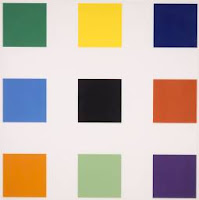 Tate Liverpool has an exhibition devoted to the rise of colour in recent and contemporary abstract art. Such exhibitions can do two things: chart the social history of art movements through the artworks displayed; and/or chart the visual possibilities: in this case the phenomenology of colour. There was some indication of the latter aim through reference in the exhibition and its presence in the bookshop of Goethe’s Theory of Colour. Strangely, though, interesting and enjoyable though it was, I don’t think I gained much of an insight into the possibilities of colour for art. I’m not sure that colour itself came across very well. But how could it? How could one chart colour simply by displaying it? (It’s not as though it’s missing from other art exhibitions.)
Tate Liverpool has an exhibition devoted to the rise of colour in recent and contemporary abstract art. Such exhibitions can do two things: chart the social history of art movements through the artworks displayed; and/or chart the visual possibilities: in this case the phenomenology of colour. There was some indication of the latter aim through reference in the exhibition and its presence in the bookshop of Goethe’s Theory of Colour. Strangely, though, interesting and enjoyable though it was, I don’t think I gained much of an insight into the possibilities of colour for art. I’m not sure that colour itself came across very well. But how could it? How could one chart colour simply by displaying it? (It’s not as though it’s missing from other art exhibitions.)Many years ago I wrote one of the essays for my masters degree on Wittgenstein’s Remarks on Colour, which itself was influenced by Goethe’s work. Naomi Eilan kindly agreed to supervise me. I attempted to steer a minimalist course: seeing the comments on the absence of brown traffic lights or glowing grey as merely grammatical remarks needing no further underpinning but nevertheless providing real insight into the possibilities of colour itself (not merely ‘grammar’ on a pejorative understanding of that term). Every week, sitting in the Keynes room at King’s College (I seem to recall much stained glass and faintly pre-Raphaelite murals), drinking robustly black coffee, Naomi would listen to my efforts sadly and conclude the session with the words: ‘Next week, Tim we’ll have to get into some sexy metaphysics’.
Naomi, of course, has a particular project with a particular view of the possibilities of philosophical insight and explanation. But I wonder whether there is a more general worry about responding to Wittgenstein’s last work which sees it as importantly incomplete: a mere description of (some of) the phenomena but not getting at their somehow hidden underlying reality. Colour in particular seems to be an area where the gap between language as a medium of representation and what is represented seems greatest. (This may be related to the urge to think of colour in particular in appeals to qualia in the philosophy of mind.)
